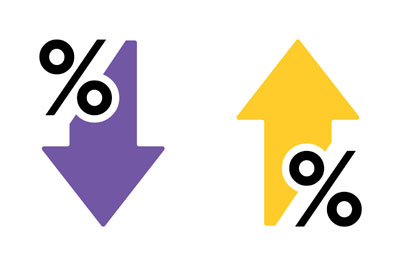Rising Interest Rates Could Reduce Lump-Sum Pension Payouts
by Jay Mota, CFP, CDFA, CHGC, Ameriprise Financial –
December 29, 2022

Many employees today participate in a defined benefit retirement plan. A key feature of this benefit type is that it allows some participants to choose, at the point of retirement, to either receive the vested benefit amount either in a single lump-sum payout or through a series of payments over time.
Since choosing between these two payment options is often permanent and irreversible, helping clients make a thoughtful and informed decision is key. Complicating matters in this decision-making process today, however, is rising interest rates — particularly as it relates to the value a participant receives under the lump-sum distribution option.
Rising interest rates typically have a negative impact on asset values. This is due to the way present value is calculated for an asset. The economic principal known as “discounted cash flow,” states that the current value of a financial asset is the present value of all future cash flows. Simply put, this means that the way asset values are determined is by discounting all future cash flows back to present time, using a stated discount rate (an interest rate).
Since future cash flows are reduced by the discount rate, a higher discount rate will result in a lower present value of an asset. The opposite is also true. A lower discount rate leads to a higher present value.
Consider the following example of this concept. Assuming a 4-percent discount rate, a participant would be indifferent between receiving $1,000 per month for the next 10 years (a total of $120,000 over time) or $98,770 today. However, if the discount rate is increased to 6 percent, the participant would accept receiving $90,073 today (roughly 9 percent less) or the same fixed payment of $1,000 per month for the next 10 years. Intuitively, what the math behind these calculations is suggesting is that a participant receiving a lump-sum payout will be able to reinvest these assets at prevailing interest rates. Thus, at higher interest rates, less initial principal is required to generate future cash flows; at lower interest rates, more initial capital will be required.
Interest rates today are dramatically higher than last year as the economy wrestles with elevated inflation. For example, the yield on a 10-year Treasury bond, which acts as a common benchmark rate for the economy, has more than doubled in 2022, starting the year at 1.24 percent and closing at 3.41 percent on Sept. 14, 2022. Furthermore, specific to defined benefit retirement plans, a blend of corporate bond yields is commonly used to calculate lump-sum payout amounts. Importantly, these corporate yields are typically higher than those on Treasury bonds with similar maturities.
Stark yield increases have not only increased borrowing costs for many consumers and businesses across the economy, but they may have notably caused a reduction in lump-sum payouts for participants in defined benefit plans. Many plan participants, especially those nearing or at their desired retirement age, could soon see their lump-sum value fall should interest rates move higher or retirement plan calculations catch up with current market levels.
Understandably, participants will have questions about their course of action, including:
- Does it make more sense to take a reduced lump-sum from my pension or receive the annuity amount over time?
- Can I still afford to retire on this lump-sum value?
- What interest rate and inputs are used to calculate my specific lump-sum payout, and how likely are these inputs to change over the next year?
Savvy CPAs should be prepared to answer these questions for their clients.
This information is provided only as a general source of information and is not intended to be the primary basis for investment decisions. It is not a solicitation to buy or sell the securities mentioned and should not be construed as advice designed to meet the particular needs of an individual investor. Please seek the advice of a financial advisor regarding your particular financial concerns.
Jay MotaJay Mota, CFP, CDFA, ChFC, is a financial advisor at Ameriprise Financial Services, LLC. Ameriprise Financial Services is an NJCPA premier partner. |
This article appeared in the winter 2022/23 issue of New Jersey CPA magazine. Read the full issue.